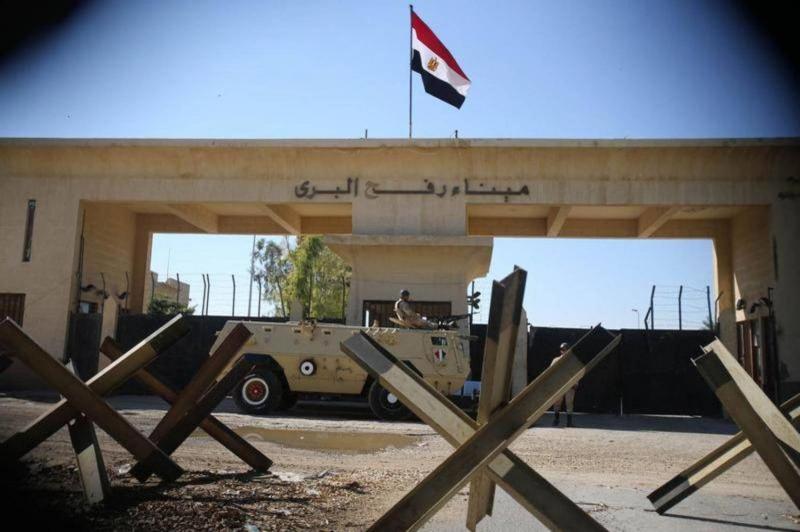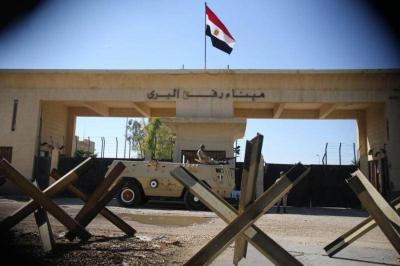The Rafah crossing, controlled by Egypt, is the main lifeline connecting the Palestinian Gaza Strip to the outside world and is not managed by Israel. Located on Gaza's southern border with Egypt, it has become the focal point for efforts to deliver humanitarian aid to the residents of the Strip and allow the injured and holders of foreign passports to leave. Israel imposed a "complete blockade" on the territory following a Hamas attack that resulted in hundreds of casualties in Israel on October 7.
*Why is the Rafah crossing in the news?*
With Israel's border crossings closed, Rafah has become the only way for Gaza residents to exit the 360-square-kilometer coastal enclave. Egyptian media and a border source reported that the first group of injured people evacuated from Gaza crossed into Egypt today, Wednesday, under a Qatari-mediated agreement. Border sources indicated that the first batch of foreign passport holders crossed thereafter. Qatar mediated an agreement between Egypt, Israel, and Hamas, coordinated with the United States, to allow for limited evacuations. Although Israel does not directly control the Rafah crossing, it monitors all activities in southern Gaza from the Karam Abu Salem military base and conducts other monitoring operations.
*Why is the Rafah crossing significant in this conflict?*
Israel controls all maritime and aerial entry points to Gaza, as well as most of its land borders. Current restrictions have intensified to a full blockade following October 7, making Rafah the sole entry point for humanitarian aid.
*What are the latest updates on delivering aid to Gaza?*
Egypt stated in the early days of the war that the Rafah crossing was open but non-operational due to Israeli shelling in Gaza. After discussions regarding the conditions for delivering aid, the first humanitarian convoy crossed into Gaza on October 21. UN relief officials report that an average of 14 aid trucks pass through Rafah daily, significantly fewer than the hundred trucks estimated to be needed to meet basic needs. Normally, over 400 trucks enter Gaza daily through various routes to supply 2.3 million people. Desperate for basic supplies such as bread, residents of Gaza stormed UN warehouses on October 29 to seize flour and other food items.
*What difficulties are there in obtaining large quantities of aid through Rafah?*
Relief officials say that Rafah's primary role in the past was civilian and it was not equipped for large-scale relief operations. Egyptian officials stated that Israeli inspection procedures "significantly delay aid delivery." Aid trucks pass through the Egyptian border gate at Rafah before traveling over 40 kilometers to the Egyptian-Israeli al-Aouja crossing for inspection, according to agreements in negotiations with Israel. The trucks return to Egypt empty and reload aid onto separate trucks for delivery to Gaza. Israel refuses to allow fuel into Gaza, stating that Hamas might use it to achieve its military goals. Aid during past conflicts was mainly delivered from Israel, and the UN’s aid operations for Palestinians have been conducted through Israel since the 1950s. The UN is urging Israel to open the Karam Abu Salem crossing near the junction of Israel, Gaza, and Egypt.
*Can American citizens and dual nationals leave Gaza?*
The agreement mediated by Qatar allows for limited evacuations of foreign passport holders. A Western official stated that Israel and Egypt agreed on the list of these individuals. Egyptian sources indicated on Wednesday that about 500 foreign passport holders are expected to pass through the Rafah crossing in the coming days.
*Why does Egypt impose restrictions on crossing from Rafah?*
Egypt is the only Arab country with a shared border with Gaza and fears the destabilizing effects of Palestinian displacement. Egypt and Jordan have warned against forcing Palestinians to leave their lands. Egyptian President Abdel Fattah el-Sisi is also concerned about the armed Hamas movement, which was founded by the Muslim Brotherhood. Since Hamas took control of Gaza in 2007, Egypt has tightened restrictions on the flow of people and goods. Tens of thousands of Palestinians crossed into Sinai in 2008 after Hamas created breaches in border fortifications, prompting Egypt to build a stone and cement wall. Egypt is worried about security near the Gaza border in northeastern Sinai, where it faced an Islamist insurgency that peaked after 2013 but has largely suppressed since then. Egypt has mediated between Israel and Palestinian factions during previous conflicts and disturbances, but it also closes the border in such cases, allowing only for aid deliveries and the exit of those seeking medical treatment while preventing mass movement of individuals.
*Will residents of Gaza leave the territory?*
The UN states that about 1.6 million Palestinians in Gaza, or two-thirds of the territory's population, are refugees. Many of them intend to avoid a repeat of the mass displacement that occurred during the 1948 war following the establishment of the State of Israel, when around 700,000 Palestinians fled or were expelled from their homes and denied the right to return. Palestinians refer to this as the "Nakba." Israel denies that it expelled Palestinians, claiming it was attacked by five Arab nations.




